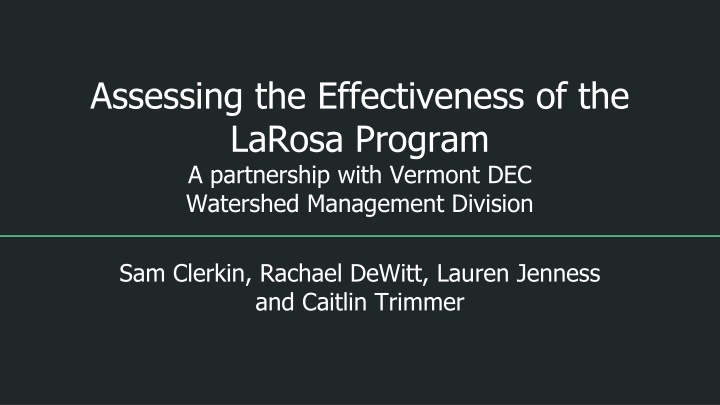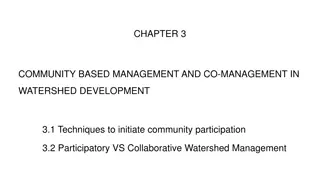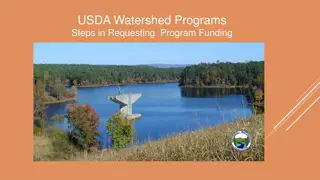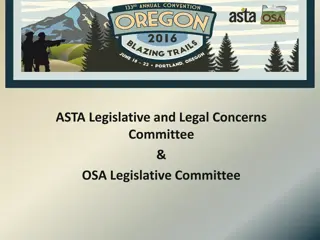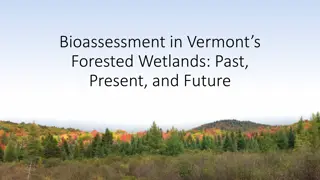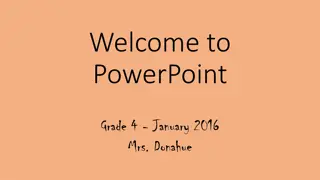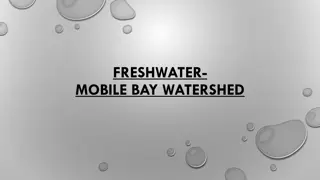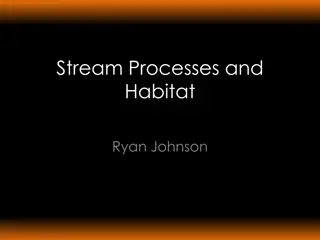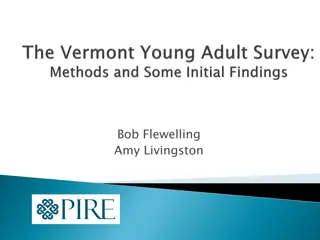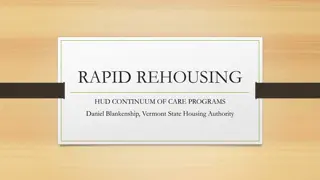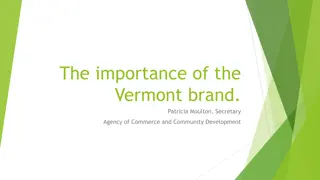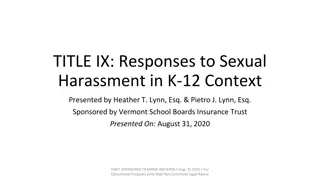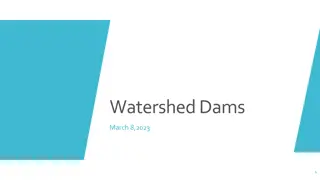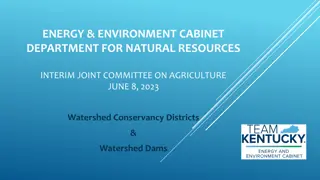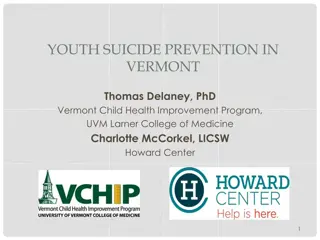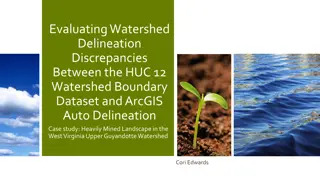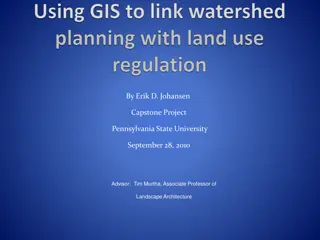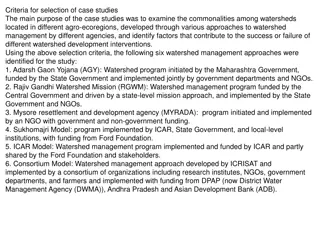Evaluating Effectiveness of LaRosa Program in Partnership with Vermont DEC Watershed Management Division
This project aims to assess the LaRosa program's effectiveness through fostering communication, evaluating its impact, and identifying challenges faced by watershed associations. Various methods such as interviews, surveys, and email communication were used to gather insights. Key questions revolved around data collection, lab training, program effectiveness, and success indicators defined by the organizations involved.
Download Presentation

Please find below an Image/Link to download the presentation.
The content on the website is provided AS IS for your information and personal use only. It may not be sold, licensed, or shared on other websites without obtaining consent from the author.If you encounter any issues during the download, it is possible that the publisher has removed the file from their server.
You are allowed to download the files provided on this website for personal or commercial use, subject to the condition that they are used lawfully. All files are the property of their respective owners.
The content on the website is provided AS IS for your information and personal use only. It may not be sold, licensed, or shared on other websites without obtaining consent from the author.
E N D
Presentation Transcript
Assessing the Effectiveness of the LaRosa Program A partnership with Vermont DEC Watershed Management Division Sam Clerkin, Rachael DeWitt, Lauren Jenness and Caitlin Trimmer
Background UVM Service Learning Course Vermont DEC Watershed Management Division La Rosa Program Watershed Association Involvement Connecticut River in Bellows Falls, VT which is monitored by the Connecticut River Watershed Council. (http://www.pictureconnecticutriver.com/NH-VT%20Gallery/files/page6-1025-full.html)
Goal 1: Foster communication between the LaRosa program and the individual watershed organizations that comprise it Goals Goal 2: Assess the effectiveness of the LaRosa program in order for it to evolve in the future Goal 3: Determine roadblocks watershed associations may encounter while attempting to implement and plan projects.
Interviewed individuals from citizen-based water monitoring organizations in other states Sent emails to watershed associations Sent surveys Conducted interviews with watershed associations Methods
Questions Asked: About the watershed How do you use the data you collect? If you had $10,000 to coordinate your work related to the LaRosa program, how would you use it? About collecting water samples Would more lab training/field training be effective? What kind? What would this look like? About the effectiveness of the program What is your perspective regarding the creation and submission of the Quality Assurance Report? About the lab experience Are there scheduling challenges with sampling and submission? What are they?
What does success mean for your organization? Good quality data retrieval Long-term water quality monitoring Submission of useful data Ability to present the data to the public Production of a report Inspire community involvement
Friends of the Mad River Is there any communication/collaboration between your group and other watershed associations? If so, how? Black River Action Team Addison County River Watch Collaborative White River Partnership
If you had $10,000 to coordinate your work related to the LaRosa program, how would you use it? Paying Stipends Hiring Consultants, Interns, Engineers, Data Analyzer Paying Volunteers & Project Coordinator Sampling Increase sampling sites Increase number of tests Compiling Data and Implementation Making recommendations based on the data Remediation efforts Compiling data from previous years Education and outreach Sample Transport Reimburse for gas/milage Hire courier service
Would more lab training/field training be effective? What kind? What would this look like? Sampling done in teams is more effective Field training from the DEC would be helpful Overall satisfied with training for staff and volunteers Interest in a training video to be widely distributed Williston Conservation Commission Incorporate feedback
How do the watershed associations use the data? Reports that can be distributed to the community Evaluation of safety for recreational use in some areas Identification of long-term trends for remediation planning Warren Falls Assess developmental and agricultural impacts
What is the effectiveness of the LaRosa Program? Benefits: Opportunities for Improvement: The LaRosa program is great! More analysis from lab is needed Well supported and well run Clarification with how data is being used Staff are helpful Readily available for assistance DEC assistance in determining solutions and implementation of solutions Free lab support and analysis is critical, some groups cannot function without this Assistance getting samples to the lab
Are there other approaches the DEC should consider in the evolution of the LaRosa program? 17 groups specifically answered this question. Five mentioned the difficulty in getting the samples to and from the lab. Three groups mentioned wanting better analysis of their data. Two mentioned wanting consistent/fast data results. Two groups mentioned wanting to know how the state is using their data.
Key Recommendations the Watershed Associations are Interested In: More material online about the LaRosa program Transportation system for water sample bottles Help with the analysis of their water sample data Information about how the state uses their data Faster results from the lab
La Rosa Partnership Website Creation of watershed association summaries Next Steps
Acknowledgements Thank you for providing help and support Neil Kamman Zac Ispa-Landa Marcella Dent Jim Kellogg Guy Roberts Bethany Sargent Dan Needham Linda Green Kris Stepenuck Fritz Gerhardt Marty Illick
Acknowledgements Thank you for participation! Corrie Miller: Ryan O Donnell: Southeastern Vermont Watershed Commission Mary Russ: White River Partnership Dan Sharpe: Lake Iroquois Association Ann Smith: Friends of Winooski River Denise Smith: Friends of Northern Lake Champlain Hillary Solomon: Poultney Mettowee Nat. Res. Cons. District Kristen Underwood: Addison County River Watch Collaborative Matt Witten: Addison County River Watch Collaborative Aaron Worthley: Huntington Conservation Commission Shawn White: Chittenden County Stream Team, Winooski Headwaters, and 4 Rivers Partnership Friends of Mad River Peter Benevento: Mary Childs: Andrea Donlon: Fritz Gerhardt: Bill Hoadley: Eric Howe: Marty Illick: John Little: Bill Manner: Nanci McGuire: Franklin Watershed Association White River Natural Resource Conservation District Connecticut River Watershed Council (CRWC) Memphremagog Watershed Association South Chittenden River Watch (SCRW) Williston Conservation Commission Lewis Creek Association Missisquoi River Basin Association (MRBA) Black River Action Team (BRAT) Rutland Natural Resource Conservation District Upper and Otter Creek Watershed Black River Action Team (BRAT) Kelly Stettner:
If you would like to learn more...attend the Water Monitoring Council Meeting...
